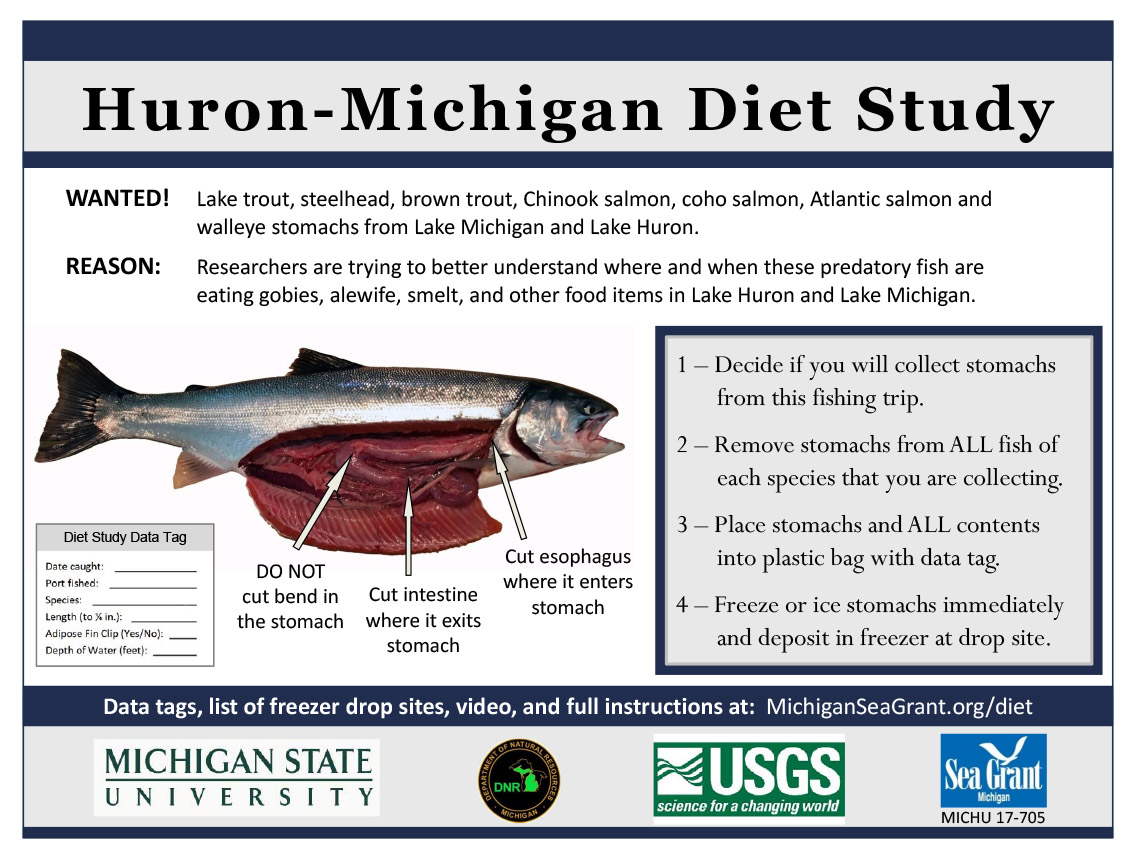Fish diet study reaches another milestone
Researchers at MSU recently completed dissection of 4,538 trout, salmon, and walleye stomachs collected from Lake Huron and Lake Michigan in 2018.

Michigan State University students working under the direction of Dr. Brian Roth have been busy at work analyzing the stomach contents of predator fish collected from Lake Huron and Lake Michigan. Identification and weighing of stomach contents is now complete, and the team is working to tally the results.
In 2018, 2,585 stomachs were collected in Lake Michigan and 1,953 were collected in Lake Huron for a grand total of 4,538. Most of these stomachs were collected from anglers by partner agencies working around the lakes, but anglers can also submit collect stomachs on their own. In 2018, Lake Huron anglers 396 stomachs from their own catches and Lake Michigan anglers collected 35.
Fall, spring donations needed
Volunteer stomach collection is especially important in fall and spring due the low number of stomachs collected by partner agencies early and late in the season. To submit stomach sam ples after a fishing trip, follow these four easy steps:
ples after a fishing trip, follow these four easy steps:
- Decide if you will collect stomachs from this fishing trip. It is not necessary to collect stomachs from every fishing trip taken over the course of the year.
- Remove stomachs from ALL fish of each species that you are collecting. It is not necessary to collect stomachs from all species, but if you collect one stomach from a steelhead then collect stomachs from all steelhead caught during that trip. It is especially helpful to collect less-common species like steelhead, brown trout, and Atlantic salmon even if you do not collect more common species like Chinook salmon and lake trout.
- Place entire intact stomach into plastic bag with data tag. Make sure to include only one stomach per plastic bag. Researchers prefer intact stomachs with no punctures or holes, and will not accept ripped, open, stomachs with large holes, or prey separated from the stomach. These stomachs might be missing small or heavily-digested food items that can bias the study.
- Freeze or ice stomachs immediately and deposit in freezer at drop site.
Full instructions and freezer drop sites are available at MichiganSeaGrant.org/diet. Diet study signs are also posted at access sites around Lake Michigan and Lake Huron. Data tags are available at some drop sites and can be printed at home. The video below also provides helpful hints on stomach removal:
Help fund this project
Even if you don’t participate in collecting samples, you can contribute to funding the project on this CrowdPower page. More than 30 individuals have contributed to the crowd-funding effort, in addition to several fishing organizations. The Grand Rapids Steelheaders Foundation, the Grand Haven Steelheaders Foundation, Southwest Michigan Steelheaders, Detroit Area Steelheaders, Pentwater Sportfishing Association, and Saginaw Bay Walleye Club have all contributed generous donations. Additional funding was awarded by the Great Lakes Fishery Trust, will allow MSU researchers to analyze stomach contents from trout, salmon, and walleye through 2021.
Michigan Sea Grant helps to foster economic growth and protect Michigan’s coastal, Great Lakes resources through education, research and outreach. A collaborative effort of the University of Michigan and Michigan State University and its MSU Extension, Michigan Sea Grant is part of the NOAA-National Sea Grant network of 34 university-based programs.
This article was written by Michigan Sea Grant Extension Educator Dr. Dan O'Keefe under award NA14OAR4170070 from the National Oceanic and Atmospheric Administration, U.S. Department of Commerce through the Regents of the University of Michigan. The statements, findings, conclusions, and recommendations are those of the author(s) and do not necessarily reflect the views of the National Oceanic and Atmospheric Administration, the Department of Commerce, or the Regents of the University of Michigan.



 Print
Print Email
Email

